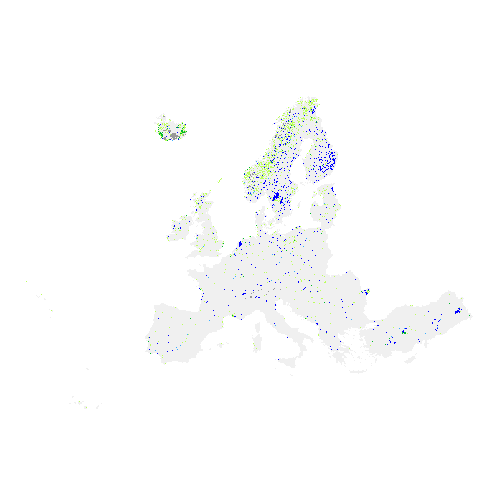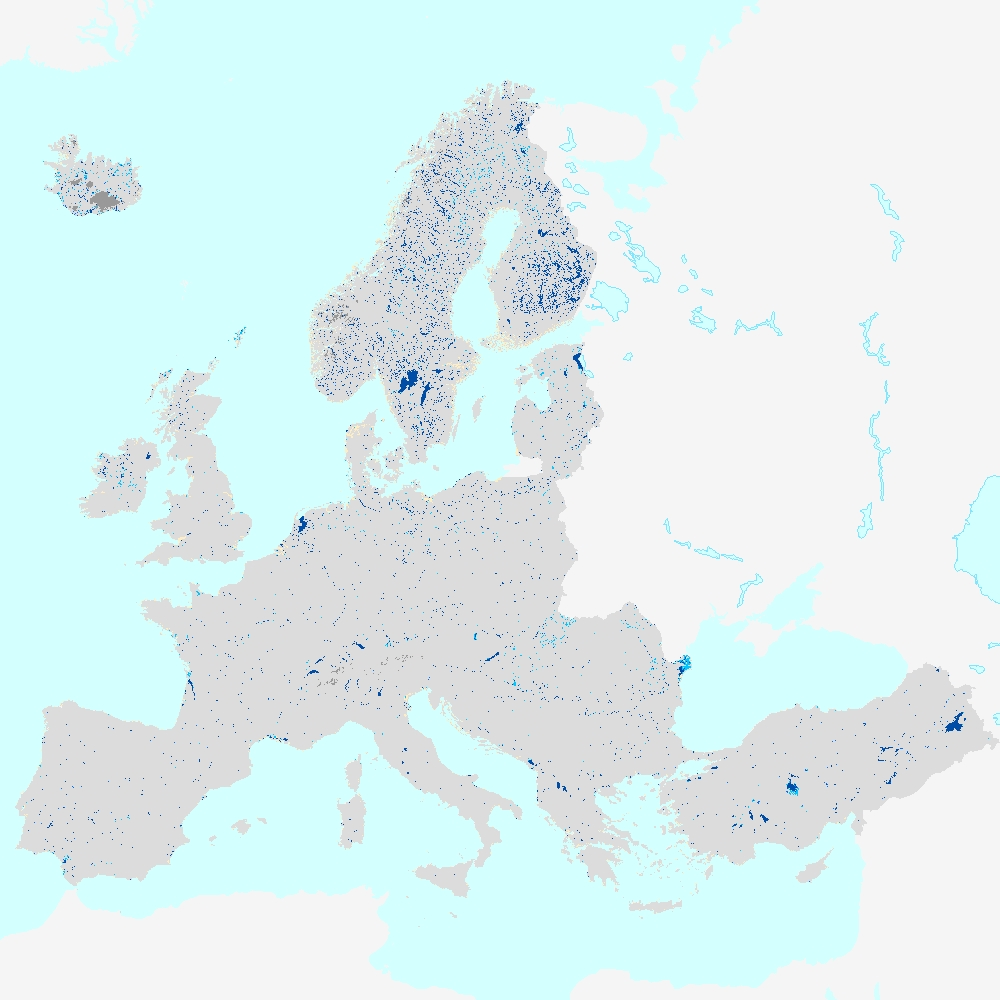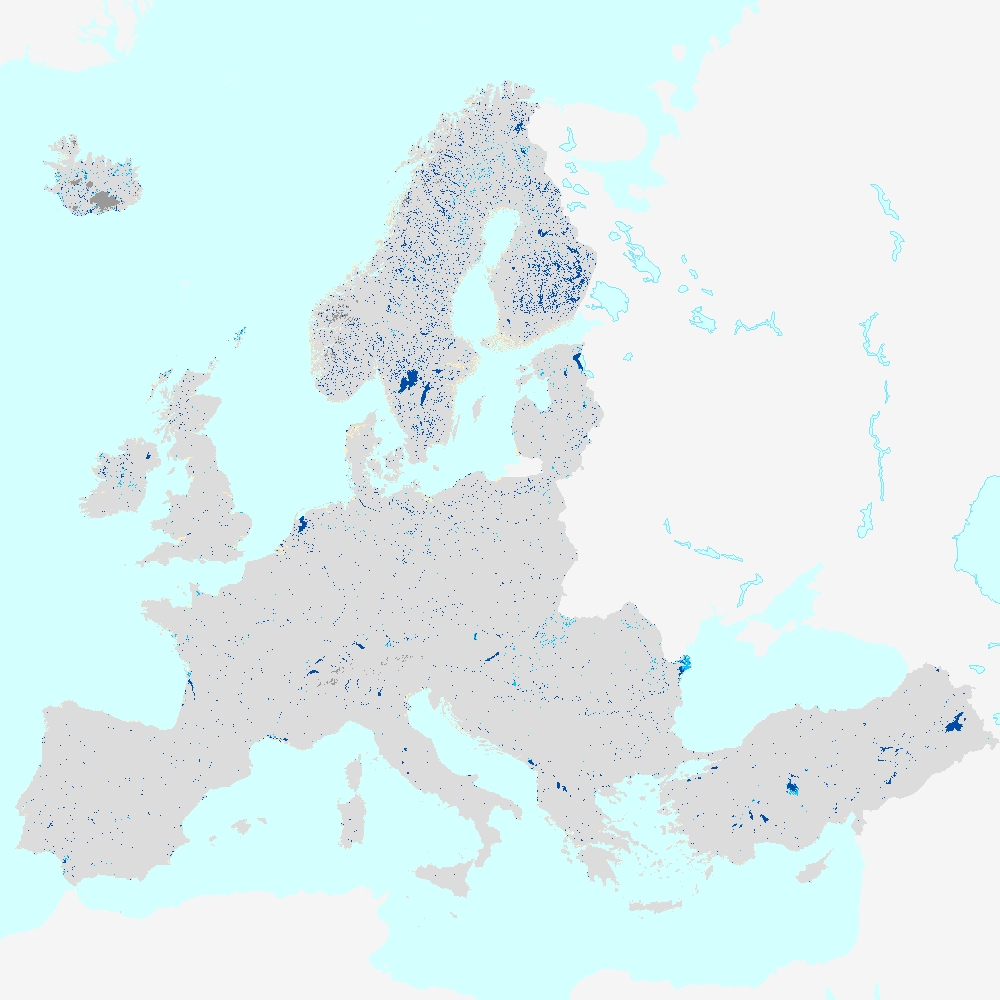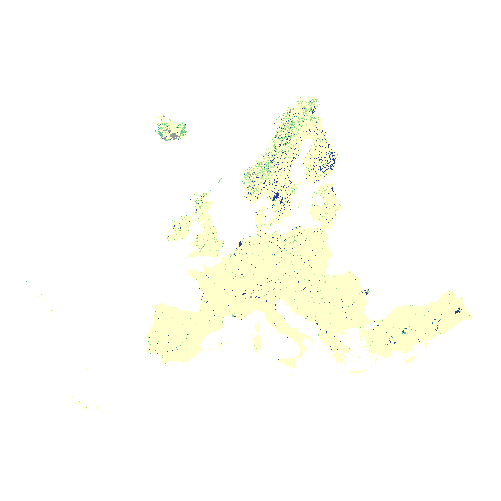IDP_topics_Water
Type of resources
Available actions
Topics
INSPIRE themes
Keywords
Contact for the resource
Provided by
Years
Formats
Representation types
Update frequencies
status
Scale
Resolution
-

EU-Hydro is a dataset for all EEA39 countries providing photo-interpreted river network, consistent of surface interpretation of water bodies (lakes and wide rivers), and a drainage model (also called Drainage Network), derived from EU-DEM, with catchments and drainage lines and nodes. EU-Hydro river network is divided into 35 basins (covering all EEA39 countries) available in geodatabase format with geometries and attributes (including HYDRO Feature Dataset with 12 Feature Classes in turn): Oder, Elbe, Rhine, Seine, Vistula, Skjern, Loire, Garonne, Rhone, Duero, Ebro, Tajo, Jucar, Guadalquivir, Shannon, Thames, Tweed, Iceland, French Guiana, French Islands, Hondo, Mesima, Tevere, Po, Tirso, Pinios/Bulgaria, Nemunas, Danube, Gota, Angerman, Neva, Kemi, Tana, Vorma, Turkey. The production of EU-Hydro public beta and the derived layers was coordinated by the European Environment Agency in the frame of the EU Copernicus programme.
-

The Copernicus High Resolution Water and Wetness (WAW) 2015 layer is a thematic product showing the occurrence of water and wet surfaces over the period from 2009 to 2015 for the EEA38 area and the United Kingdom . This metadata corresponds to the aggregation of the 20m classified product into a 100m raster. The production of the High Resolution Water and Wetness layers was coordinated by the European Environment Agency (EEA) in the frame of the EU Copernicus programme. Two WAW products are available: - The main Water and Wetness (WAW) product, with defined classes of (1) permanent water, (2) temporary water, (3) permanent wetness and (4) temporary wetness. - The additional expert product: Water and Wetness Probability Index (WWPI). The products show the occurrence of water and indicate the degree of wetness in a physical sense, assessed independently of the actual vegetation cover and are thus not limited to a specific land cover class and their relative frequencies. Data is provided as a mosaic of the full area, and as tiles with a side length of 1000 km x 1000 km. In 2020, due to methodological improvements, the temporary wet class has been reprocessed during the update for the 2018 reference year.
-

The Copernicus High Resolution Water and Wetness (WAW) 2018 layer is a thematic product showing the occurrence of water and wet surfaces over the period from 2012 to 2018 for the EEA38 area and the United Kingdom. Two products are available: - The main Water and Wetness (WAW) product, with defined classes of (1) permanent water, (2) temporary water, (3) permanent wetness and (4) temporary wetness. - The additional expert product: Water and Wetness Probability Index (WWPI). The products show the occurrence of water and indicate the degree of wetness in a physical sense, assessed independently of the actual vegetation cover and are thus not limited to a specific land cover class and their relative frequencies. The production of the High Resolution Water and Wetness layers was coordinated by the European Environment Agency (EEA) in the frame of the EU Copernicus programme. The dataset is provided as 10 meter rasters in 100 x 100 km tiles grouped according to the EEA38 countries and the United Kingdom (fully conformant with the EEA reference grid).
-

The Copernicus High Resolution Layer Water and Wetness (WAW) 2018 is a thematic product showing the occurrence of water and wet surfaces over the period from 2012 to 2018 for the EEA38 area and the United Kingdom. This metadata refers to the 100 meter aggregate raster, provided as a full EEA38 and United Kingdom mosaic (fully conformant to with the EEA reference grid). The production of the High Resolution Water and Wetness layers was coordinated by the European Environment Agency (EEA) in the frame of the EU Copernicus programme Two Water and Wetness products are available: - The main Water and Wetness (WAW) product, with defined classes of (1) permanent water, (2) temporary water, (3) permanent wetness and (4) temporary wetness. - The additional expert product: Water and Wetness Probability Index (WWPI). The products show the occurrence of water and indicate the degree of wetness in a physical sense, assessed independently of the actual vegetation cover and are thus not limited to a specific land cover class and their relative frequencies.
-

The combined Water and Wetness product is a thematic product showing the occurrence of water and wet surfaces over the period from 2009 to 2015. Two products are available: The main Water and Wetness (WAW) product with defined classes of (1) permanent water, (2) temporary water, (3) permanent wetness and (4) temporary wetness; and the additional expert product: Water & Wetness Probability Index (WWPI). These products show the occurrence of water and indicate the degree of wetness in a physical sense, assessed independently of the actual vegetation cover and are thus not limited to a specific land cover class and their relative frequencies. The production of the high resolution water and wetness layers was coordinated by the European Environment Agency (EEA) in the frame of the EU Copernicus programme.
-

The combined Water and Wetness (WAW) product is a thematic product showing the occurrence of water and wet surfaces over the period from 2012 to 2018 for the EEA38 area and the United Kingdom. Two products are available: - The main Water and Wetness (WAW) product, with defined classes of (1) permanent water, (2) temporary water, (3) permanent wetness and (4) temporary wetness. - The additional expert product: Water and Wetness Probability Index (WWPI). The products show the occurrence of water and indicate the degree of wetness in a physical sense, assessed independently of the actual vegetation cover and are thus not limited to a specific land cover class and their relative frequencies. The production of the High Resolution Water and Wetness layers was coordinated by the European Environment Agency (EEA) in the frame of the EU Copernicus programme. The dataset is provided as 10 meter rasters in 100 x 100 km tiles grouped according to the EEA38 countries and the United Kingdom (fully conformant with the EEA reference grid).
-

The combined Water and Wetness product is a thematic product showing the occurrence of water and wet surfaces over the period from 2009 to 2015. Two products are available: The main Water and Wetness (WAW) product with defined classes of (1) permanent water, (2) temporary water, (3) permanent wetness and (4) temporary wetness; and the additional expert product: Water & Wetness Probability Index (WWPI). These products show the occurrence of water and indicate the degree of wetness in a physical sense, assessed independently of the actual vegetation cover and are thus not limited to a specific land cover class and their relative frequencies. The production of the high resolution water and wetness layers was coordinated by the European Environment Agency (EEA) in the frame of the EU Copernicus programme.
-

This dataset includes data on individual waste water treatment plants and collecting systems without UWWTP, their localisation, capacity and actual load treated, type of treatment, aggregated data on the performance of plants. The table T_UWWTP_Agglo (uwwtd_uwwtp_agglo_v4.txt) is a connection table combining data on agglomeration and waste water treatment plants aloowing repoting of situations where the ratio agglomeration:UWWTP is 1:n or m:1.
-

The dataset contains information on the European river basin district sub-units delineated for the 1st River Basin Management Plans (RBMP) under the Water Framework Directive (WFD). This data set is available only for internal use of the European Commission and the European Environment Agency. Please search for "PUBLIC VERSION" in the dataset title to access the publicly available version. The information was reported to the European Commission under the Water Framework Directive (WFD) reporting obligations. The spatial data reported under the WFD reporting obligations includes river basin districts, sub-units, surface water bodies, groundwater bodies and monitoring sites. The dataset compiles the available spatial data related to the 1st RBMPs which were due in 2010 (hereafter WFD2010). See http://rod.eionet.europa.eu/obligations/521 for further information on the WFD2010 reporting. It was prepared to support the reporting of the 2nd RBMPs due in 2016 (hereafter WFD2016). See http://rod.eionet.europa.eu/obligations/715 for further information on the WFD2016 reporting. The data reported in WFD2010 were updated using data reported in WFD2016, whenever the spatial objects are identical in 2010 and 2016. For WFD2010 objects, some information may be missing, if the objects no longer exist in the 2nd River Basin Management Plans, and were not reported in WFD2016. This dataset updates the information published in "WISE River basin districts subunits (RBDSU) - version 1.4, Jun. 2011" (https://sdi.eea.europa.eu/catalogue/srv/eng/catalog.search#/metadata/7bd28405-0f3f-4737-830a-ee80762c6aaf). Relevant concepts: River basin district: The area of land and sea, made up of one or more neighbouring river basins together with their associated groundwaters and coastal waters, which is the main unit for management of river basins. River basin: The area of land from which all surface run-off flows through a sequence of streams, rivers and, possibly, lakes into the sea at a single river mouth, estuary or delta. Sub-basin: The area of land from which all surface run-off flows through a series of streams, rivers and, possibly, lakes to a particular point in a water course (normally a lake or a river confluence). Sub-unit [Operational definition. Not in the WFD]: Reporting unit. River basin districts larger than 50000 square kilometre should be divided into comparable sub-units with an area between 5000 and 50000 square kilometre. The sub-units should be created using river basins (if more than one river basin exists in the RBD), set of contiguous river basins, or sub-basins, for example. If the RBD area is less than 50000 square kilometre, the RBD itself should be used as a sub-unit.
-

The combined Water and Wetness (WAW) product is a thematic product showing the occurrence of water and wet surfaces over the period from 2009 to 2015 for the EEA39 area. This metadata corresponds to the 20m classified Water and Wetness product. Two WAW products are available: - The main Water and Wetness (WAW) product, with defined classes of (1) permanent water, (2) temporary water, (3) permanent wetness and (4) temporary wetness. - The additional expert product: Water and Wetness Probability Index (WWPI). The products show the occurrence of water and indicate the degree of wetness in a physical sense, assessed independently of the actual vegetation cover and are thus not limited to a specific land cover class and their relative frequencies. The production of the High Resolution Water and Wetness layers was coordinated by the European Environment Agency (EEA) in the frame of the EU Copernicus programme. Data is provided as a mosaic of the full area, and as tiles with a side length of 1000 km x 1000 km.
 RUC Geo-Data catalogue
RUC Geo-Data catalogue